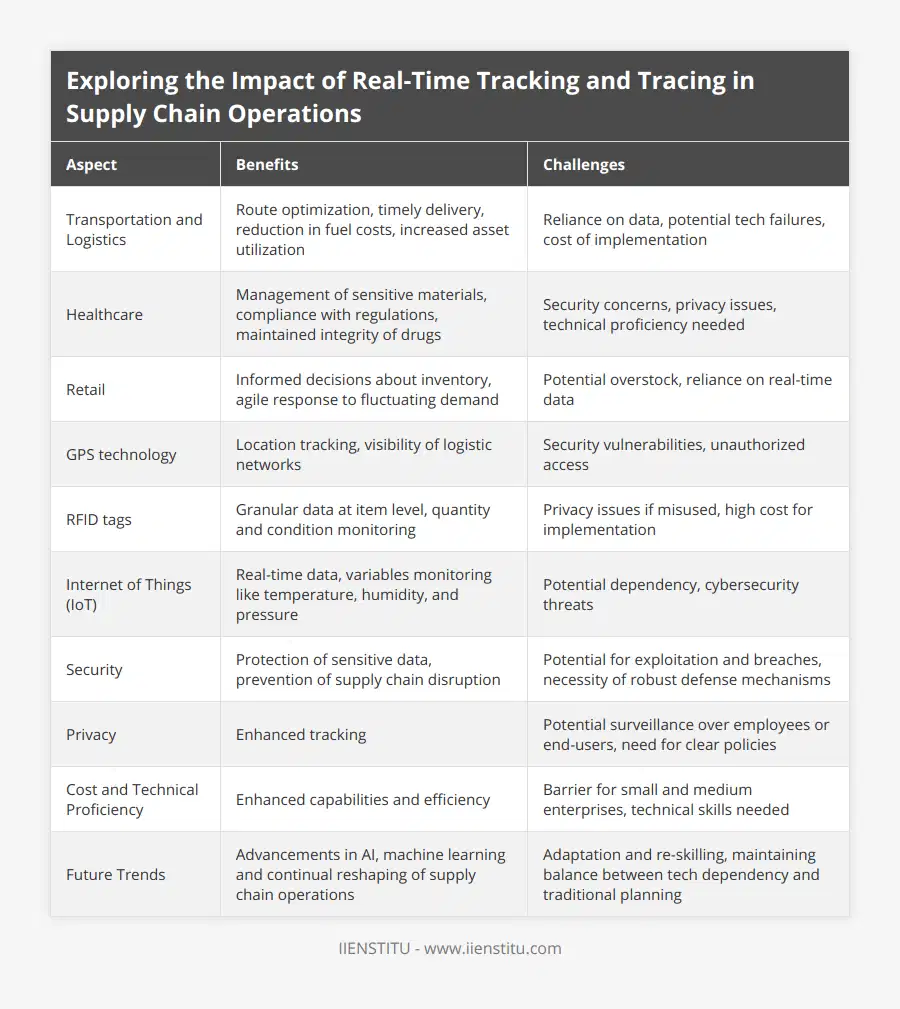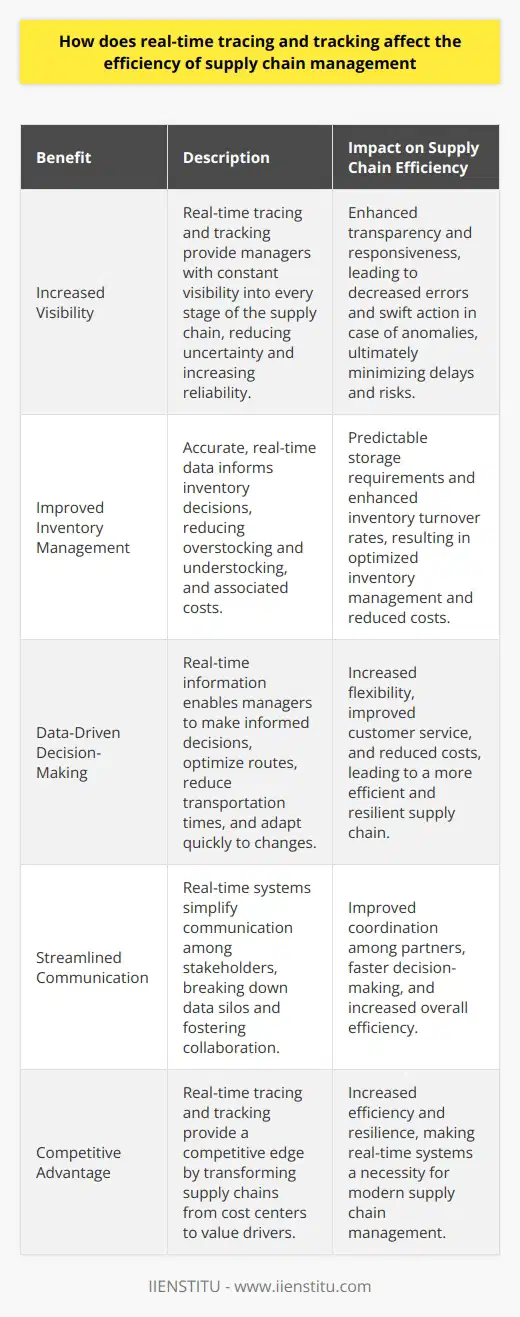In today's fast-paced and interconnected world, the way goods and information move across global supply chains has become more critical than ever. I still remember when I was a kid, my grandfather owned a small grocery store. Back then, tracking shipments meant waiting days—sometimes weeks—for updates. Nowadays, with real-time tracking and tracing, businesses operate with a level of efficiency my grandfather could only dream of.
The Heartbeat of Modern Supply Chains
Real-time tracking and tracing have emerged as the cornerstones for enhancing supply chain operations. They provide visibility and foster reliability, turning traditional business operations into dynamic, responsive systems. For anyone involved in supply chain management, understanding and leveraging these tools isn't just beneficial—it's essential.
Why Is Real-Time Tracking So Important?
Imagine ordering a package online and not knowing when it will arrive. Frustrating, right? For businesses, not knowing where their products are can lead to lost revenue, unhappy customers, and a tarnished reputation.
Customer Satisfaction: Real-time updates keep customers informed, building trust.
Risk Reduction: Spot potential issues before they become major problems.
Efficiency Boost: Optimize routes and reduce idle times.
A Personal Perspective
When I started working with a small e-commerce company, we faced countless complaints about delayed deliveries. Implementing a real-time tracking system transformed our operations. Not only did customer complaints drop, but our team could optimize supply chain management process tips we picked up along the way.
Diving into Different Sectors
Transportation and Logistics
In the world of transportation and logistics, having up-to-the-minute information is like having a superpower. Companies can manage fleets more effectively, optimize routes, and ensure timely deliveries. A friend of mine who took a logistics management course shared how real-time data reduced their company's fuel costs by 15%. That's huge!
Maximizing Inbound Logistics: Benefits, Challenges & Strategies
Efficiency in Supply Chain: The Role and Impact of Lead Time
Fuel Savings: Less idle time and better routes mean less fuel consumption.
Asset Utilization: Keep vehicles and staff productive.
Avoid Delays: Reroute around traffic or hazards in real-time.
Healthcare's Critical Need
The healthcare sector relies heavily on precision and timeliness. Real-time tracking ensures that sensitive materials, like pharmaceuticals and organs for transplant, are handled with the utmost care. I recall reading about a hospital that lost valuable time due to misplaced medical supplies. Implementing real-time tracking not only saved them money but potentially saved lives.
Temperature Monitoring: Ensure medicines remain effective.
Regulatory Compliance: Meet strict health regulations.
Patient Safety: Deliver the right supplies at the right time.
Retail Revolution
Retailers are perhaps the most visible beneficiaries of real-time tracking. With the rise of online shopping, consumers expect quick and accurate deliveries. During last year's holiday season, I ordered a gift online and was amazed at how I could track its journey—from warehouse to my doorstep.
Inventory Management: Know when to restock items.
Demand Forecasting: Respond to shopping trends promptly.
Customer Engagement: Keep buyers informed and happy.
The Technology Making It Happen
GPS: The Guiding Star
Strategic Sourcing To Maximize Cost Savings And Optimize Supplier Performance
Machine Learning Solutions For Efficient İnventory Management
At the forefront is the Global Positioning System (GPS). It's everywhere—from our smartphones to shipping containers. GPS provides real-time location data, giving both companies and customers a bird's-eye view of shipments.
RFID: Beyond Just Location
Radio-Frequency Identification (RFID) tags take tracking a step further. They offer detailed information at the item level. Think of RFID as tiny helpers that tell you not just where an item is, but what it is, how many there are, and even their condition.
Inventory Counts: Quickly scan large quantities.
Loss Prevention: Reduce theft or misplacement.
Data Gathering: Analyze movement patterns.
IoT: The Network of Everything
The Internet of Things (IoT) has amplified the capabilities of tracking systems. Sensors attached to products communicate data like temperature, humidity, and pressure. This is especially crucial for perishable goods.
An Example to Consider
A wine distributor I know uses IoT sensors to ensure their products aren't exposed to temperatures that could spoil the wine. These sensors send real-time alerts if conditions go awry, protecting their valuable inventory.
Challenges on the Horizon
Security Concerns
With great power comes great responsibility. The same systems that provide transparency can be vulnerable to cyber-attacks. Companies must invest in robust security measures.
Data Encryption: Protect information from unauthorized access.
Access Controls: Limit who can see what.
Regular Audits: Ensure systems are up-to-date.
Privacy Issues
There's a fine line between tracking products and infringing on privacy. Employees might feel uneasy if they think they're being monitored too closely.
Clear Policies: Communicate what's being tracked and why.
Anonymize Data: Use data in aggregate to protect individual identities.
Ethical Guidelines: Follow best practices to respect privacy.
Cost and Implementation Barriers
For small to medium-sized businesses, the cost of implementing these technologies can be daunting. There's also a learning curve involved.
Initial Investment: Equipment and software aren't cheap.
Training Staff: Employees need to learn new systems.
Maintenance: Ongoing costs for updates and repairs.
Overcoming the Hurdles
Some businesses start small, implementing tracking in critical areas before scaling up. Seeking government grants or partnerships can also alleviate financial burdens.
Looking Ahead: Future Trends
The Rise of Artificial Intelligence
Advancements in artificial intelligence (AI) and machine learning are set to take tracking systems to new heights. Imagine systems that not only tell you where something is but predict where issues might arise.
Predictive Analytics: Anticipate delays or demand spikes.
Automated Decisions: Adjust routes in real-time without human input.
Enhanced Efficiency: Continuously learn and improve processes.
Sector-Specific Impacts
Education and Training
Based on current trends, certificate courses online in supply chain management will soon incorporate AI and advanced analytics. This equips professionals with cutting-edge skills.
Retail and Personalized Experiences
Customized Delivery: Offer delivery options tailored to individual preferences.
Dynamic Pricing: Adjust prices based on real-time supply and demand.

Potential Drawbacks
While innovation brings benefits, it also introduces new challenges.
Over-Reliance on Technology: What happens if systems fail?
Job Displacement: Automation might reduce the need for certain roles.
Ethical Concerns: AI decisions might lack human empathy or fairness.
Embracing the Future
The transformative impact of real-time tracking and tracing in supply and chain management is undeniable. Businesses that adapt will thrive, while those that hesitate may fall behind. It's not just about technology—it's about rethinking how we operate.
Steps to Move Forward
1- Assess Needs: Identify areas where tracking can have the most impact.
2- Plan Implementation: Start small and scale up.
3- Invest in Training: Equip your team with the necessary skills.
4- Stay Updated: Technology evolves quickly—keep learning.
5- Engage Stakeholders: Include everyone from suppliers to customers in the conversation.
Conclusion
Reflecting on how far we've come since my grandfather's time, it's clear that supply chain management management has entered a new era. Real-time tracking and tracing aren't just tools—they're integral parts of modern business strategy. By embracing these technologies, we can build more resilient, efficient, and customer-focused operations.
Whether you're a seasoned professional or just starting out in scm supply, understanding these concepts is crucial. The future is bright for those willing to adapt and grow.
References
1- Chopra, S., & Meindl, P. (2019). Supply Chain Management: Strategy, Planning, and Operation. Pearson Education.
An in-depth look at supply chain strategies and the role of technology in modern operations.
2- Christopher, M. (2016). Logistics & Supply Chain Management. Pearson UK.
This book offers insights into the importance of logistics and how real-time tracking enhances supply chain efficiency.
3- Murphy, P. R., & Knemeyer, A. M. (2018). Contemporary Logistics. Pearson.
Provides contemporary views on logistics, including the challenges and technologies shaping the industry.
4- Sanders, N. R. (2020). Supply Chain Management: A Global Perspective. John Wiley & Sons.
Discusses global supply chain management and the impact of real-time data and analytics.
5- Lee, H. L. (2004). The Triple-A Supply Chain. Harvard Business Review.
An article emphasizing agility, adaptability, and alignment in supply chains, underlining the need for real-time information.
Acknowledgments
Special thanks to all the industry professionals and educators who continue to advance the field of supply chain mgmt. Your dedication drives innovation and excellence.
Note: This article incorporates key industry terms such as chain of supply management, and supply chain management, management chain supply, supply chain supply chain, and more to provide a comprehensive understanding of the topic.
Frequently Asked Questions
What are the key advantages of implementing real-time tracking and tracing in supply chain operations
Understanding Real-Time Tracking and Tracing
Supply chain operations stand at the core of modern commerce. Implementing real-time tracking and tracing significantly enhances these operations. It does so through several key advantages.
Enhanced Visibility
Real-time data improves supply chain visibility. Stakeholders see where items are at any moment. They identify the exact location of goods. This clarity cuts uncertainty in logistics.
Improved Responsiveness
Real-time systems allow quick responses. Companies detect issues immediately. They address disruptions swiftly. This agility provides a competitive edge.
Better Customer Satisfaction
Customers expect detailed shipment information. Real-time tracking meets these expectations. Clients can track their orders live. This transparency builds trust and satisfaction.
Optimized Inventory Management
Inventory levels link closely with tracking data. Real-time information fine-tunes stock levels. Companies reduce excess inventory. They dodge stockouts too. Thus, cash flow improves.
Streamlined Operations
Accuracy in tracking streamlines operations. It simplifies the shipping and receiving processes. It enhances operational efficiency. It reduces the potential for error.
Reduced Costs
Cost savings occur with real-time tracking. Fewer delays and enhanced efficiency cut costs. Precise logistics translate to monetary savings.
Data-Driven Decisions
Rich data guides decision-making. Companies access real-time analytics. They make informed choices. These choices steer towards greater operational success.
Compliance and Security
Real-time systems enhance security. They help ensure compliance. Companies meet regulatory requirements with ease. They secure the supply chain against theft and tampering.
Competitive Advantage
Real-time tracking provides a strategic advantage. It positions companies ahead of competitors. This edge is critical in a crowded marketplace.
To conclude, real-time tracking and tracing in supply chains offers multifaceted benefits. It boosts visibility, responsiveness, and customer trust. It optimizes inventory, streamlines operations, and reduces costs. It supports data-driven decisions and enhances compliance and security. Ultimately, it gives companies a vital competitive advantage.

How does real-time tracing and tracking affect the efficiency of supply chain management
Real-Time Tracing and Tracking
Impact on Supply Chain Efficiency
Real-time tracing and tracking revolutionize supply chain management. They provide visibility. Managers monitor goods constantly. They see every stage clearly. This transparency reduces uncertainty. It increases reliability. Supply chains become more responsive.
Errors decrease. Systems alert managers instantly. Anomalies trigger immediate action. This minimizes delays. Risks diminish as well. Predictability in operations improves. Managers anticipate issues effectively. They address potential disruptions swiftly.
Inventory management sees benefits too. Accurate data informs decisions. Overstocking and understocking decrease. Costs associated with excess inventory reduce. Storage requirements become predictable. This precision enhances inventory turnover rates.
Enhanced Decision-Making
Data drives decisions. Real-time information is gold here. Managers make informed choices. They optimize routes. They reduce transportation times. Costs fall. They adapt quickly to changes. Flexibility becomes a supply chain strength.
Customers enjoy improved service. Real-time updates keep them informed. Satisfaction increases. Trust in the supply chain grows. Transparent operations build customer loyalty.
Streamlined Communication
Communication simplifies with real-time systems. Stakeholders stay on the same page. Data silos break down. Everyone accesses the same information. Collaboration improves. Partners coordinate more effectively. Decision-making speeds up. Efficiency skyrockets.
Conclusion
In conclusion, real-time tracing and tracking uplift supply chain management. They offer transparency, responsiveness, and improved decision-making. These benefits make supply chains more efficient and resilient. They provide a competitive edge. Supply chains transform from cost centers to value drivers. Real-time systems are no longer a luxury. They are a necessity.

What potential challenges might organizations face when integrating real-time tracking and tracing technologies into their existing supply chain operations?
Introduction
Organizations today strive for efficiency in their supply chains. They often turn to real-time tracking and tracing technologies. These tools promise enhanced visibility and control. Yet, their integration presents unique challenges.
System Compatibility
First, consider existing infrastructures. They may lack compatibility with new technologies. Integrations need meticulous planning and execution. Systems vary in age and functionality. Aligning them requires technical expertise.
Data Management Difficulties
Tracing technologies often generate vast data quantities. Managing this influx is crucial. Storage capacity must scale accordingly. Analysis tools are needed to interpret the data. Without them, the information holds little value.
Integration Costs
Budget constraints cannot be overemphasized. Real-time solutions involve considerable investment. Costs include not only initial setup but also ongoing maintenance. These expenses can strain financial resources.
Staff Training and Adaptation
Employee training is essential. Users must understand the new systems. This process takes time and resources. Resistance to change can hinder adaptation. Organizations must invest in change management.
Process Disruption Risks
Integration may disrupt ongoing operations. Careful planning reduces this risk. However, some disruptions are inevitable. They can affect service quality and delivery timeliness.
Privacy and Security Concerns
Real-time tracking raises privacy issues. Customers and partners may express concerns. Security measures must be robust. Organizations bear the responsibility of protecting sensitive information.
Conclusion
In conclusion, the integration of real-time tracking technologies demands strategic consideration. Organizations face multiple hurdles. Tactical approaches can mitigate these challenges. Proper implementation ultimately enhances supply chain operations.



